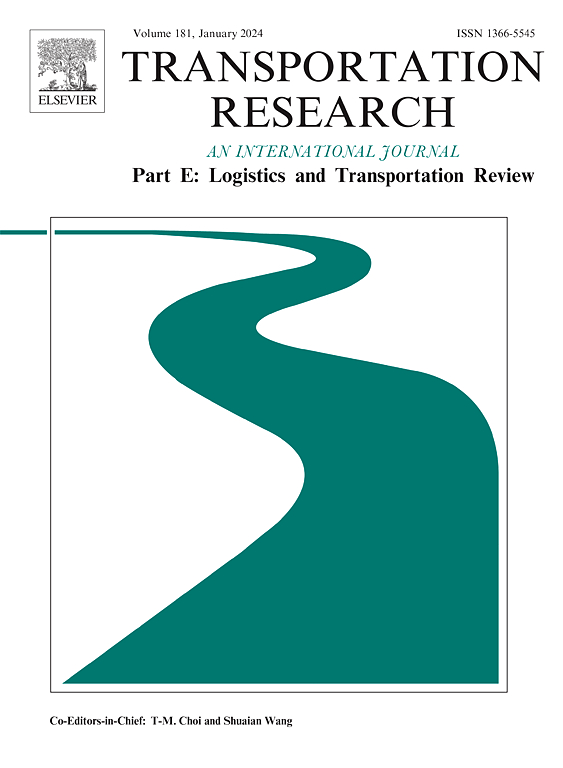Ridesharing user equilibrium model and its equivalent variational inequality formulation without monotonicity: A decomposition-based approximation approach
IF 8.3
1区 工程技术
Q1 ECONOMICS
Transportation Research Part E-Logistics and Transportation Review
Pub Date : 2025-05-20
DOI:10.1016/j.tre.2025.104140
引用次数: 0
Abstract
Ridesharing (RS), with one driver serving a rider with similar route and schedule, has long been regarded as a charming paradigm for eco-friendly mobility. However, despite the rapid growth of shared mobility platforms, ridesharing demand remains relatively low. To design appropriate network-based policies to stimulate ridesharing, solving the traffic assignment problem in the presence of ridesharing services serves as the first and fundamental step. In a general network with both car owners and non-car owners, this paper models travelers’ mode, ridesharing partner and route choices at ridesharing user equilibrium. The model allows each RS driver to serve riders between any of her/his reachable origin–destination (OD) pairs, ensures each RS rider is served door to door by one RS driver, and endogenously determines the RS driver/rider demand and ridesharing price between each OD pair. The model is formulated into a non-monotone variational inequality (VI) problem. To solve it efficiently on large-scale networks, we propose a tailored Benders decomposition-based approximation approach, which decomposes the VI problem into a subproblem and a non-monotone master problem. The subproblem is transformed into a convex programming problem, which is further equivalent to a Beckmann formulation with side constraints. And for the non-monotone master problem, we apply the constant approximation scheme to approximate it by solving a convex quadratic programming problem with off-the-shelf solvers. The convergence of the proposed algorithm is theoretically established, and the correctness of the model and the efficiency of the algorithm are demonstrated through numerical experiments based on small to large scale networks.
拼车用户均衡模型及其无单调性的等效变分不等式公式:一种基于分解的近似方法
拼车(RS),即一名司机为一名有着相似路线和时间表的乘客服务,长期以来一直被认为是一种迷人的环保出行模式。然而,尽管共享出行平台增长迅速,但拼车需求仍然相对较低。为了设计合适的基于网络的政策来刺激拼车,解决拼车服务存在的交通分配问题是第一步也是最基本的一步。在一个既有车主也有非车主的一般网络中,建立了用户均衡下的出行方式、共乘伙伴和路线选择模型。该模型允许每个RS司机为任意可达始发地对之间的乘客提供服务,保证每个RS司机由一名RS司机上门服务,并内生地决定每个OD对之间的RS司机/乘客需求和拼车价格。将该模型转化为一个非单调变分不等式问题。为了在大规模网络上有效地解决它,我们提出了一种定制的基于Benders分解的近似方法,该方法将VI问题分解为子问题和非单调主问题。将子问题转化为凸规划问题,进一步等价于带边约束的Beckmann公式。对于非单调主问题,我们采用常数逼近格式,通过求解一个凸二次规划问题来逼近它。从理论上证明了该算法的收敛性,并通过小型到大型网络的数值实验验证了模型的正确性和算法的有效性。
本文章由计算机程序翻译,如有差异,请以英文原文为准。
求助全文
约1分钟内获得全文
求助全文
来源期刊
CiteScore
16.20
自引率
16.00%
发文量
285
审稿时长
62 days
期刊介绍:
Transportation Research Part E: Logistics and Transportation Review is a reputable journal that publishes high-quality articles covering a wide range of topics in the field of logistics and transportation research. The journal welcomes submissions on various subjects, including transport economics, transport infrastructure and investment appraisal, evaluation of public policies related to transportation, empirical and analytical studies of logistics management practices and performance, logistics and operations models, and logistics and supply chain management.
Part E aims to provide informative and well-researched articles that contribute to the understanding and advancement of the field. The content of the journal is complementary to other prestigious journals in transportation research, such as Transportation Research Part A: Policy and Practice, Part B: Methodological, Part C: Emerging Technologies, Part D: Transport and Environment, and Part F: Traffic Psychology and Behaviour. Together, these journals form a comprehensive and cohesive reference for current research in transportation science.

 求助内容:
求助内容: 应助结果提醒方式:
应助结果提醒方式:


